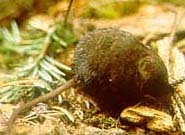 The Baird’s shrew (Sorex bairdii) was once thought to belong to other North American shrew species such as the vagrant shrew (Sorex vagrans) and the dusky shrew (Sorex monticolus). By 1990, biologists realized that the Baird’s shrew was a distinct species that did not breed with any other of the six shrew species it lives near. They are only found in the forests of one corner of the state of Oregon, from the Cascade Range to the Pacific coast. Despite living in a small area, their population is holding steady and they are not considered endangered.
The Baird’s shrew (Sorex bairdii) was once thought to belong to other North American shrew species such as the vagrant shrew (Sorex vagrans) and the dusky shrew (Sorex monticolus). By 1990, biologists realized that the Baird’s shrew was a distinct species that did not breed with any other of the six shrew species it lives near. They are only found in the forests of one corner of the state of Oregon, from the Cascade Range to the Pacific coast. Despite living in a small area, their population is holding steady and they are not considered endangered.Baird’s shrew is named after its discoverer, biologist Spencer Fullerton Baird (1823 to 1887). A friend of John James Audubon, Baird also discovered a tapir, a beaked whale, a dolphin and a pocket gopher, which are all named after him.
General Appearance
This is a small rodent with a pointed head, large human-like ears and a long, naked tail. Both makes and females appear alike. Adults weigh anywhere from 0.194 to 0.395 of an ounce (or 5.5 to 11.2 grams). Both males and females grow to a nose to tail length of 3.94 to 5.63 inches (or 100 to 143 millimeters).
The Baird’s shrew changes color during the seasons.
Life Habits
Not much is known about the Baird’s shrew because of its incredibly shy nature and secretive habits, but biologists know that it has a voracious appetite. It can eat a wide variety of insects and spiders. Biologists trying to study the secretive shrew have discovered it likes liver pate. It eats about its own body weight in insects or spiders every day because it has such a high metabolism.
Baird’s shrews have two breeding seasons in early spring and late summer, when insects are at their most plentiful. Although their gestation is unknown, it is thought to be only a few weeks because the species has two breeding seasons. Females give birth to a litter of 4 to 7 hairless, blind babies. These shrews prefer to live in damp areas of pine forests where rotting logs and the insects that inhabit rotting wood are abundant. It is unknown how long Baird’s shrews can live, but most species of shrews can only live about 18 to 24 months.
Keywords: brown
The Baird's shrew is listed as Least Concern (LR/lc), lowest risk. Does not qualify for a more at risk category. Widespread and abundant taxa are included in this category, on the IUCN Red List of Threatened Species
Countries
United States
Custom Search